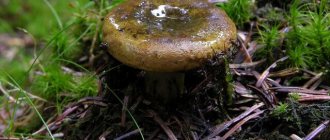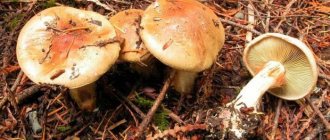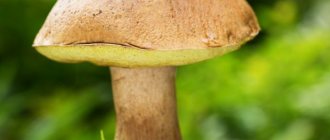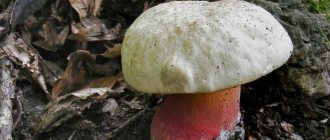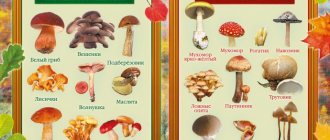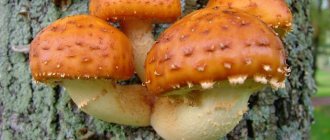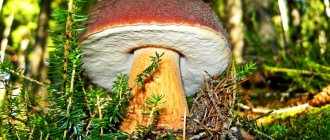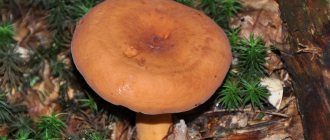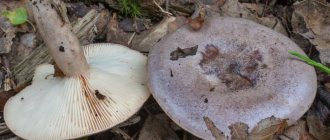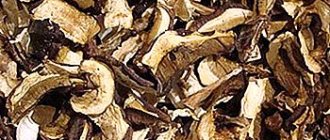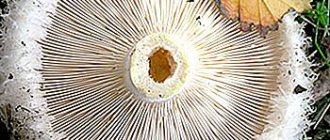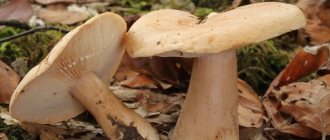Description
The yellow breast is a prominent representative of the Mlechnikov genus, the Russula family. It has gained popularity among mushroom pickers due to its cold resistance, wide distribution and excellent taste.
Appearance
It is advisable to begin the description of Podskrebysh with its appearance. The mushroom is quite large in size and can reach 25 cm in height. Its cap is large, 5–15 cm in diameter, convex at the beginning of growth, later it almost completely straightens out and becomes flat. In the center of the hat there is a funnel-shaped, slightly depressed formation. It is shaggy at the edges and curved inward. The color of the hat, as the name implies, is yellow, slightly dirty or golden-olive.
Important! Milk mushrooms, due to the bitter taste of the milky juice, belong to the second category of edible mushrooms. At the same time, there are no poisonous mushrooms similar in appearance to Podskrebysh.
On the surface you can see well-defined dark concentric circles, which are considered a distinctive feature of milk mushrooms. Directly under the hat is the fleshy part, represented by numerous thick, densely packed white or cream-colored plates. Often, during the aging process, the plates are partially transferred to the leg. The flesh of Volnukha is white, in older specimens it is yellow.
The structure is quite brittle, but dense, and often crumbles when transported in a basket. When the pulp breaks, a milky juice appears, which has a thick texture and a pleasant aroma. When exposed to air, the juice quickly turns yellow. As various photos show, the leg of the mushroom is short, no more than 5-6 cm high, thick, about 4 cm in diameter, has a cylindrical shape and a color identical to that of the hat. The inside is hollow, and the surface is completely covered with a sticky mucous mass.
Variability
As noted above, during the aging process, the appearance of milk mushrooms is subject to some changes. In particular, in older specimens the white or cream color of the plates changes to yellow. The same applies to the pulp, which is yellow in an adult mushroom. Over time, brown spots may form on the caps.
Golden-yellow breast (golden milkweed): photo and description
| Name: | Milk breast golden yellow |
| Latin name: | Lactarius chrysorrheus |
| Type: | Inedible |
| Synonyms: | Golden milky breast, Golden milky milkweed |
| Characteristics: |
|
| Taxonomy: |
|
The breast is golden-yellow from the Russula family, inedible due to its bitter juice. Known as: golden milky milkweed, golden milky milkweed, Lactarius chrysorrheus.
Description of golden yellow milk mushroom
The species differs from other milkweeds in color. A detailed description of the mushroom will prevent it from being confused with other representatives of the forest kingdom.
Description of the cap
The convex cap gradually opens, a depression is formed in the center, and the strongly tucked edges of the old fruiting bodies are wavy and curved upward. The smooth skin is matte, shiny in the rain, with pronounced spots and circular zones. The width of the cap is 4-10 cm. The color ranges from ocher, pale salmon or orange-pink to red.
The thick flesh is brittle, odorless, and yellow when cut due to the oozing whitish juice, peppery in taste, which quickly turns yellow. The thick plates are bifurcated towards the end; in young specimens they are white, in old specimens they are creamy-pink.
Description of the leg
The cylindrical leg is low, up to 8 cm, with age-related changes:
- first with a powdery, whitish, then with a smooth surface of orange-pinkish color;
- solid at first, gradually forms a hollow channel;
- thickened below.
Where and how does the golden yellow milk mushroom grow?
The species is often found from early summer to autumn in the deciduous forests of the temperate zone of Eurasia. Mushrooms create mycorrhiza with oaks, chestnuts, and beeches. The fruiting bodies are arranged singly or in clusters.
Is the mushroom edible or not?
Golden-yellow milkweeds are inedible due to their very bitter juice. There are claims that mushrooms need to be soaked for 5-7 days, and the acridity from the pulp disappears.
Doubles and their differences
The inedible species is very similar to the oak milkweed and the true camelina.
The main differences between golden-yellow milk mushrooms and frequently collected doubles:
- the juice of the camelina is intensely orange, gradually becoming greenish, like the cut pulp;
- the plates of the camelina are orange-red in color and turn green when pressed;
- the liquid that appears on the cut of the oak milk mushroom is white-watery and does not change color in the air;
- the pulp of the poultice is whitish, with a strong odor;
- the skin is brown, dry, with indistinct circles.
The valuable yellow milk mushroom, similar in name, grows in damp areas of spruce-birch forests and is not among the twins.
Conclusion
The golden-yellow milk mushroom can be accidentally taken into a basket. Mushrooms should be sorted carefully. This type is soaked separately.
Other names
The edible mushroom Yellow breast has several names: Volnukha, Podskrebysh, Podgruzd . The Latin name, which appeared in 1891, is Lactarius scrobiculatus, which translated into Russian means “bruised.” Before this, the mushroom was named Agaricus scrobiculatus in 1772 and Galorrheus scrobiculatus in 1871.
Did you know? In the old days, Gruzd was called the “king” of mushrooms. And this is not surprising, because previously it was the only mushroom that was suitable for pickling.
How to view Rothko's paintings?
Numerous reviews from eyewitnesses say that the paintings of the American abstract artist are capable of literally absorbing the viewer, creating the feeling that you are standing in front of a portal into which you will inadvertently fall through and emerge in another dimension. By the way, you can feel a significant difference if you look at the artist’s works, at least on videos that capture his exhibitions in museums or art galleries. The video frames show more clearly the nuances of applying paints to the canvas, the degree of their density/transparency, and mixing layers at the boundaries of rectangles. Photographs do not convey the glow emanating from some paintings, while the effectiveness of others is greatly enhanced by the conditions in which they are exhibited and the combination with neighboring paintings and lighting.
By the way, the artist himself attached great importance to these factors. He could easily refuse an offer to present his paintings in a prestigious gallery if he was not guaranteed that all his requirements would be met. And while participating in the “15 Americans” exhibition, Rothko kept turning off several light sources in the room where his works were exhibited. This did not help much: as soon as the artist left the gallery, the curator turned them on again, appealing to the fact that otherwise it would be too dim and gloomy.
Similar species
A distinctive feature of yellow Milk mushrooms is the corresponding coloring of the hat and legs.
However, Volnukha has external similarities with other varieties of mushrooms:
- The milk is real . It has a lighter, almost white, convex-flat or funnel-shaped hat. The surface is slimy, wet, the pulp is hard, with a pronounced fruity odor, and secretes milky juice. The leg is short, rather thick, white in color, with a smooth surface.
- The breast is purple . The mushroom belongs to the inedible class. It is characterized by the presence of a yellow cap of a convex or flat shape, which has slight pubescence at the edges. The purple breast milk differs from the yellow one in the color of its milky juice - in the former it is lilac. The leg is quite loose, brittle, and at high humidity it becomes very sticky and sticky. The inside is dense, yellowish in color, with a pleasant delicate smell.
- The breast is fringed . A lamellar mushroom with a convex cap, on the surface of which fibers are scattered, forming a “fringe” along the edges. The color of the hat is yellowish or ocher. The inner part has a fleshy, fairly tough, but at the same time brittle structure, light yellow in color. The leg is dense, cylindrical in shape, and becomes hollow with age.
Black breast (Lactarius necator)
This dark mushroom is very tasty in pickles, acquiring a wine-like, reddish hue. The cap is rounded-flat, later sunken, up to 20 cm in diameter, brownish-yellow with an olive tint or dark green, the surface may be covered with concentric circles. The edges are curved, slightly fringed. The skin is slimy, especially in rainy weather.
A greenish sticky stalk up to 8 cm high, tight and full, becoming hollow towards the base, the surface is covered with dents. In the upper part, thinned plates of a yellowish-olive color descend on it. The white flesh is fleshy, greyish when crushed, releasing a milky liquid that turns purple when exposed to air. The cap is often dirty, the surface is covered with soil particles and debris, and it has to be scraped off before cooking.
Black breast
Ecology, where and when they grow
Scrapers prefer to grow in whole families. The zone of their greatest distribution is coniferous and deciduous forests, in particular birch, pine, and spruce forests. This type of mushroom bears fruit from August until the onset of the first frost. The optimal conditions for good growth of Milk mushrooms are considered to be high humidity and heavy rainfall.
Learn how to make a salad with chicken, mushrooms and walnuts.
In a dry summer, there is no hope for a decent harvest of Podgruzdi. Volnukha grow in columns, they hide under leaves, pine needles, grass, so mushroom pickers should work hard to find them. It is best to look for mushrooms in the lowlands, in clearings, in the northern part of the forest planting.
Time and place of fruiting
Rowing is common throughout Russia, but it is not common.
Large groups of mushrooms can only be found in forests in areas with temperate climatic conditions. Myceliums prefer to settle on the woody remains of coniferous species. Therefore, you should look for rows in coniferous plantings. Mushrooms can be found under pine trees (hence the name pine honey fungus), as well as on larch stumps, wood debris, and dead wood.
The fruiting period begins in July and ends in September. The peak activity of myceliums is observed in August - the first ten days of September.
For its ability to bear fruit in clumps and love for dead wood, this variety of rows is called honey mushroom. But, unlike the latter, yellow-red mushrooms grow together in small groups - only 4-5 fruits.
How to collect correctly
The very first milk mushrooms appear in August, they grow in large groups and hide under leaves or grass. Having seen a small leafy tubercle, you should carefully stir up the formation with a stick and “free” the Scrapper. In order not to harm the mycelium, it is forbidden to pull out or tear off Volnukha. It is recommended to cut off the leg at the base with a sharp knife to avoid damaging the body.
This will allow the mushroom family to emerge the following year. Experienced mushroom pickers do not advise “hunting” for old or damaged specimens, since they may contain an increased concentration of substances harmful to human health that have accumulated during their growth.
Taste qualities
Yellow Mushroom is a mushroom that has excellent taste, which is almost impossible to confuse with others. Despite the fact that the fruit body is characterized by a large amount of unpleasant bitter juice, with proper heat treatment the taste completely disappears. At the same time, this property of Podskrebysh has a great advantage - due to the bitterness of the pulp, it is never affected by worms or small insects.
You will be interested to know how to close eggplants “like mushrooms” for the winter.
Milk mushrooms are aspen, fluffy, tender and papillary
Aspen breast in the photo
(Lactarius controversy) in the photo
Aspen milkweed (Lactarius controversy) is conditionally edible. The cap is 10-30 cm, concave, with a deeply tucked edge, white. The plates are thick and light pink in color. The leg is short and white, 3-7 cm long, 2-4 cm thick. The milk is white, does not change color, with a burning taste. Spore powder is colorless or white.
Grows in aspen groves that have arisen in self-sown aspen fields. It grows in groups hidden in the grass, together with boletuses. Also found under poplars.
Fruits from August to October.
The aspen milk mushroom has no poisonous counterparts.
Fluffy breast in the photo
(Lactarius pubescens) in the photo
The breast is fluffy, the milkweed (Lactarius pubescens) has a cap with a diameter of 2–7 cm, thin-fleshy, concave-prostrate, with a curled, hairy edge, and hairy. With age, the cap is usually bare, sticky, cream-colored, darker in the center - to ocher or pinkish-ocher. The plates are narrow, whitish, becoming pinkish-cream over time. Leg 2-5 x 1-2 cm, whitish above, reddish or pinkish-reddish below, hollow. The pulp is dense, white, pungent and pungent. The milky juice is white, pungent, and does not change color in air.
Growth. Grows under birch trees.
Fruiting. Fruiting bodies are formed in August – October.
Usage. Inedible mushroom.
Tender breast in the photo
(Lactarius tabidus) in the photo
The tender milk mushroom (Lactarius tabidus) is described as similar to the marsh milk mushroom. The cap is 1–3.5 cm in diameter, often with a cone-shaped tubercle in the center, orange-red-brown or orange-red-red, with a ribbed edge. Stem 2–4 x 0.1–0.3 cm, cap color. The milky sap is white and turns yellow in air.
Growth. Found in marshy areas among mosses.
Fruiting. Fruiting bodies are formed in August – October.
Usage. Nutritional qualities have not been studied.
Papillary breast in the photo
(Lactarius mammosus) in the photo
The papillary breast (Lactarius mammosus) has a cap with a diameter of 3–9 cm, thin-fleshy, flat or concave-spread, often with a tubercle in the center, first with a bent and then an outstretched edge. The cap is gray-brown, dark brown, dark gray-brown or black-brown, sometimes with a purple tint, fades to yellowish with age, dry, fibrous-felt or fibrous-scaly. The plates are frequent, narrow, yellow, reddish-reddish over time, and turn brown when pressed. The stalk is 3-7×0.8-2 cm, cylindrical, with time with a canal, whitish, with age the color of the cap, in places of pressure it becomes brown-ocher.
The flesh of the cap is whitish, dark under the skin, and in the stem it is reddish-reddish, dense, sweetish, odorless in fresh mushrooms, and aromatic when dried. The milky juice is white, the color does not change in air, at first it is sweetish, then pungent or bitter, and in old mushrooms it is almost absent.
Growth. Grows in coniferous forests on sandy soils, usually in groups.
Fruiting. Fruiting bodies are formed in August – October.
Usage. Inedible mushroom.
This video shows milk mushrooms in their natural habitat:
- Author: admin
Rate this article:
- 5
- 4
- 3
- 2
- 1
(37 votes, average: 3.7 out of 5)
Share with your friends!
Methods of use
Residents of Russia consider Podskrebysh especially valuable. Here it is fried, boiled, salted or pickled. The recipe for salted mushrooms is considered a classic one. This type of mushroom is not used for drying. Modern cooking has a huge number of methods for preparing the described mushrooms, however, the basis of such recipes is almost identical. Before salting or pickling Podgruzdi, they must be properly prepared to remove the unpleasant bitter taste.
For this:
- mushroom raw materials are cleaned, carefully sorted, washed several times in cold water;
- milk mushrooms are poured with salted water and soaked for 1-2 days.
After this, the raw materials are ready for further preparation. Instead of soaking, you can boil the mushroom mass twice. The main ingredients for pickling are salt, water and, accordingly, mushrooms. Often the recipe is supplemented with a variety of spices and herbs: currant leaves, dill, garlic, horseradish root, bay leaf, pepper, etc.
Important! It is prohibited for children under the age of 12 to consume yellow breast milk, since the child’s body is not able to digest and properly assimilate the product.
One of the most favorite delicacies is salted mushrooms fried with onions in vegetable oil. This treat is used as an addition to the main dish or as a filling in pies or pizza.
Video: salted milk mushrooms
Frying yellow-brown rows
Frying mushrooms is a completely simple process, especially since the recipe for making yellow-brown row does not require expensive ingredients. However, you and your household will be able to enjoy the amazing taste and aroma of the dish.
- 1 kg of rows;
- 300 g onions;
- 150 ml vegetable oil;
- 300 g sour cream;
- 1 tsp. paprika;
- 1/3 tsp. ground black pepper;
- 50 g chopped parsley;
- Salt - to taste.
- Clean the rows, cut off the tip of the stem, wash and cut into pieces.
- Boil in salted water for 15 minutes, regularly skimming the foam from the surface.
- Drain the water, add a new portion and cook for another 30 minutes.
- While the rows are cooking, peel the onion, cut into half rings and fry until soft over low heat.
- Place the boiled mushrooms in a colander, drain and fry in a separate frying pan for 30 minutes.
- Combine with onion, salt, add pepper and paprika, mix.
- Fry for 10 minutes over low heat and add sour cream. It is better to beat sour cream with 1 tbsp. l. flour so that it does not curl.
- Continue simmering over low heat for 10 minutes.
- Before serving, sprinkle the fried rows with chopped parsley.
| Name: | Row yellow-red |
| Latin name: | Tricholomopsis rutilans |
| Type: | Conditionally edible |
| Synonyms: | Blushing row, Yellow-red false row, Yellow-red honey fungus, Red honey fungus, Pine honey fungus, Cortinellus rutilans |
| Characteristics: |
|
| Taxonomy: |
|
The yellow-red row is a representative of agaric mushrooms that grow in Russia. It is distinguished by the bright color of its cap.
Eat with caution, only after heat treatment
Properties of yellow milk mushroom
In addition to the fact that yellow breast milk, when properly prepared, has excellent taste, it is also a very healthy product. The mushroom is characterized by a rich, balanced chemical composition, which is represented by vitamins C, E, PP and group B, acids, polysaccharides, potassium, calcium and phosphorus, and fiber. In folk healing, Volnukha is used for the treatment and prevention of various diseases.
- They:
- have a diuretic effect and allow you to remove stones from the kidneys;
- fight many pathogenic bacteria and microorganisms;
- activate the digestion process, accelerate metabolic processes;
- strengthen the immune system, increase the body's protective functions;
- normalize the functioning of the nervous and cardiovascular systems;
- cleanse blood vessels, strengthen the heart muscle;
- normalize blood glucose levels;
- allow you to fight extra pounds and are effective in losing weight;
- have a beneficial effect on the condition of the skin, hair and nails.
Did you know? Milk mushroom is widely used in the pharmaceutical field for the production of drugs intended for the successful treatment of tuberculosis.
Possible harm
Almost any mushrooms, in particular Milk Mushrooms, belong to the category of “heavy” foods, so when consuming them you should follow some rules. First of all, children under 12 years of age, pregnant women or women during the breastfeeding period should avoid eating Scraper. It is recommended to eat mushrooms with caution for people who have problems with the digestive tract, during exacerbation of any chronic ailments, or with serious liver and kidney diseases.
It must be remembered that milk mushrooms are conditionally edible mushrooms, which require high-quality, rather lengthy primary processing before consumption. It is strictly forbidden to eat raw or insufficiently processed Podgruzdi, as this can lead to serious intoxication of the body.
Oak milkweed (Lactarius insulsus)
The cap is spread out, then funnel-shaped with edges turned down, up to 12 cm in diameter. The skin is brown-orange, with a reddish tint, covered with brown spots. Yellowish plates descend on the stem of the same color. The pulp is fleshy, creamy white, when broken it acquires a pink tint and releases a watery white liquid with a pungent taste and a slight mushroom odor. The mushroom is used for pickling and is considered conditionally edible. Another name for oak milk mushroom is oak milk cap.
Oak milk mushroom
